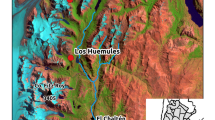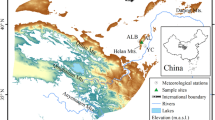Abstract
Climate refugia are anomalous “pockets” of spatially or temporally disjunct environmental conditions that buffer distinct flora and fauna against prevailing climatic conditions. Physiographic landscape features, such as large water bodies, can create these micro-to-macro-scale terrestrial habitats, such as the prevailing westerly winds across the Laurentian Great Lakes that create relatively cooler leeward conditions in spring and relatively warmer leeward conditions in autumn. The leeward Great Lakes climate effects create refugia (popularly known as a “fruit belt”) favorable for fruit-bearing trees and shrubs. These fruit belt refugia owe their existence to seasonal inversions whereby spring cooling prevents early flower budding that leaves fruit trees susceptible to late spring killing frosts, and autumn warming prevents early killing frosts. With global climate change, however, warmer summers and milder winters, and corresponding warmer waters, might erode the leeward delaying effect on spring flowering, creating a paradoxical situation in which warming increases the risk of frost damage to plants. We evaluated the success of regional agriculture in the Great Lakes fruit belt to test our hypothesis that warmer spring climate (and concomitant warmer lake waters) correspond with degraded fruit production. We also examined long-term trends in Great Lakes climate conditions. We found that the cold-sensitive fruit tree (apple, grape, peach, and cherry) refugia were destabilized by relatively warmer springs. Moreover, we found several indicators that lake waters are warming across the Great Lakes, which portends negative consequences for agricultural and natural plant communities in the Great Lakes region and in similar “fruit belt” refugia worldwide.




Similar content being viewed by others
Availability of data and material
The data generated and analyzed for the current study are available in the SUNY Buffalo State Digital Commons (https://digitalcommons.buffalostate.edu/biology_data/11/).
Code availability
R Statistical Program
References
Akaike H (1973) Information theory as an extension of the maximum likelihood principle. In: Petrov BN, Csaki F (eds) Second International Symposium on Information Theory. Akademiai Kiado, Budapest, pp 267–281
Belda M, Holtanová E, Halenka T, Kalvová J (2014) Climate classification revisited: from Köppen to Trewartha. Clim Res 59:1–13
Bradford MA, Warren RJ II, Baldrain P et al (2014) Climate fails to predict wood decomposition at regional scales. Nat Clim Chang 4:625–630
Burnett AW, Kirby ME, Mullins HT, Patterson WP (2003) Increasing Great Lake–effect snowfall during the twentieth century: a regional response to global warming? J Clim 16:3535–3542. https://doi.org/10.1175/1520-0442(2003)016<3535:IGLSDT>2.0.CO;2
Cannell MGR, Smith RI (1986) Climatic warming, Spring Budburst and Forest Damage on Trees. J Appl Ecol 23:177. https://doi.org/10.2307/2403090
Caprio JM, Quamme HA (1999) Weather conditions associated with apple production in the Okanagan Valley of British Columbia. Can J Plant Sci 79:129–137. https://doi.org/10.4141/P98-028
Cohen J, Screen JA, Furtado JC et al (2014) Recent Arctic amplification and extreme mid-latitude weather. Nat Geosci 7:627–637. https://doi.org/10.1038/ngeo2234
Coumou D, Di Capua G, Vavrus S et al (2018) The influence of Arctic amplification on mid-latitude summer circulation. Nat Commun 9:2959. https://doi.org/10.1038/s41467-018-05256-8
Day DF (1832) The plants of buffalo and its vicinity. Bull Buffalo Soc Nat Sci 9:66–79
de Melker S (2012) A sour season for Michigan’s cherry farmers. PBS News Hour
DeGaetano A (2017) In the northeast, just one cold day can keep the apples away. ClimateWatch Magazine
Dobrowski S (2011) A climatic basis for microrefugia: the influence of terrain on climate. Glob Chang Biol 17:1022–1035
Eichenlaub VL (1979) Weather and Climate of the Great Lakes Region. University of Notre Dame Press, Notre Dame
Ellis F (1880) The fruit belt. In: History of Berrien and Van Buren Counties. Michigan. D.W. Ensign & Co., Philadelphia, pp 118–126
Francis JA, Vavrus SJ, Cohen J (2017) Amplified Arctic warming and mid-latitude weather: new perspectives on emerging connections. WIREs Clim Change 8:e474. https://doi.org/10.1002/wcc.474
Gough RE, Abraham J (1997) Growing fruit under the big sky. J Small Fruit Vitic 5:1–12. https://doi.org/10.1300/J065v05n02_01
Gougherty AV, Gougherty SW (2018) Sequence of flower and leaf emergence in deciduous trees is linked to ecological traits, phylogenetics, and climate. New Phytol 220:121–131. https://doi.org/10.1111/nph.15270
Grossman E (2014) Why you shouldn’t hope for an early spring. Climate Central
Gu L, Hanson PJ, Post WM et al (2008) The 2007 Eastern US spring freeze: increased cold damage in a warming world? BioScience 58:253–262. https://doi.org/10.1641/B580311
Henne PD, Hu FS, Cleland DT (2007) Lake-effect snow as the dominant control of mesic-forest distribution in Michigan, USA. J Ecol 95:517–529
Izquierdo-Verdiguier E, Zurita-Milla R, Ault TR, Schwartz MD (2018) Development and analysis of spring plant phenology products: 36 years of 1-km grids over the conterminous US. Agric For Meteorol 262:34–41. https://doi.org/10.1016/j.agrformet.2018.06.028
Keddy PA (1981) Vegetation with Atlantic Coastal Plain affinities in Axe Lake, near Georgia Bay, Ontario. Can Field-Nat 95:241–248
Keppel G, Niel KPV, Wardell-Johnson GW et al (2012) Refugia: identifying and understanding safe havens for biodiversity under climate change. Glob Ecol Biogeogr 21:393–404. https://doi.org/10.1111/j.1466-8238.2011.00686.x
Kunkel KE, Easterling DR, Hubbard K, Redmond K (2004) Temporal variations in frost-free season in the United States: 1895–2000. Geophysical Research Letters 31. https://doi.org/10.1029/2003GL018624
Kunkel KE, Ensor L, Palecki M et al (2009) A new look at lake-effect snowfall trends in the Laurentian Great Lakes using a temporally homogeneous data set. J Great Lakes Res 35:23–29. https://doi.org/10.1016/j.jglr.2008.11.003
Mcwhirter S (2019) Fruit belt identified as especially susceptible to climate change. Traverse City Record-Eagle, Traverse City
Michalak JL, Lawler JJ, Roberts DR, Carroll C (2018) Distribution and protection of climatic refugia in North America. Conserv Biol 32:1414–1425. https://doi.org/10.1111/cobi.13130
Moran RE, Sun Y, Geng F et al (2011) Cold temperature tolerance of trunk and root tissues in one- or two-year-old apple rootstocks. Hort Sci 46:1460–1464. https://doi.org/10.21273/HORTSCI.46.11.1460
Morelli TL, Daly C, Dobrowski SZ et al (2016) Managing climate change refugia for climate adaptation. PLoS One 11:e0159909. https://doi.org/10.1371/journal.pone.0159909
Osland MJ, Enwright N, Stagg CL (2014) Freshwater availability and coastal wetland foundation species: ecological transitions along a rainfall gradient. Ecology 95:2789–2802
Palmer T (2014) Record-breaking winters and global climate change. Science 344:803–804. https://doi.org/10.1126/science.1255147
Peattie DC (1922) The Atlantic Coastal Plain element in the flora of the Great Lakes. Rhodora 24(57–70):80–88
Pinheiro J, Bates D, DebRoy S, Sarkar D, R Core Team (2021). nlme: Linear and Nonlinear Mixed Effects Models. R package version 3.1–153, https://CRAN.R-project.org/package=nlme
R Development Core Team Version 3.5.1 (2020) R: a language and environment for statistical computing. Version 3.6.2. R Foundation for Statistical Computing, Vienna URL http://cran.r-project.org. Accessed 11/1/2021
Reznicek AA (1994) The disjunct coastal plain flora in the Great Lakes region. Biol Conserv 68:203–215. https://doi.org/10.1016/0006-3207(94)90408-1
Rochette P, Bélanger G, Castonguay Y et al (2011) Climate change and winter damage to fruit trees in eastern Canada. Can J Plant Sci. https://doi.org/10.4141/P03-177
Rull V (2009) Microrefugia. J Biogeogr 36:481–484. https://doi.org/10.1111/j.1365-2699.2008.02023.x
Sahu N, Saini A, Behera SK et al (2020) Why apple orchards are shifting to the higher altitudes of the Himalayas? PLoS One 15:e0235041. https://doi.org/10.1371/journal.pone.0235041
Salazar-Gutierrez MR, Chaves B, Anothai J et al (2014) Variation in cold hardiness of sweet cherry flower buds through different phenological stages. Sci Hortic 172:161–167
Schwartz MD, Ahas R, Aasa A (2006) Onset of spring starting earlier across the Northern Hemisphere. Glob Chang Biol 12:343–351. https://doi.org/10.1111/j.1365-2486.2005.01097.x
Scott RW, Huff FA (1996) Impacts of the Great Lakes on regional climate conditions. J Great Lakes Res 22:845–863
Seeley M, Goring S, Williams JW (2019) Assessing the environmental and dispersal controls on Fagus grandifolia distributions in the Great Lakes region. J Biogeogr 46:405–419. https://doi.org/10.1111/jbi.13491
Singh J, Silva K, Fuchs M, Khan A (2019) Potential role of weather, soil and plant microbial communities in rapid decline of apple trees. PLoS One 14:e0213293
Tayyebi A, Jenerette GD (2016) Increases in the climate change adaption effectiveness and availability of vegetation across a coastal to desert climate gradient in metropolitan Los Angeles, CA, USA. Sci Total Environ 548–549:60–71
Tulowiecki SJ (2021) Modeling the geographic distribution of pawpaw (Asimina triloba [L.] Dunal) in a portion of its northern range limits, western New York State, USA. Plant Ecol 222:193–208. https://doi.org/10.1007/s11258-020-01098-x
U.S. Global Change Research Program, Wuebbles DJ, Fahey DW, et al (2017) Climate science Special report: fourth national climate assessment, Volume I. U.S. Global Change Research Program
Vermette SJ (2020) Western New York’s (WNY’s) five climate zones. Proc Rochester Acad Sci 21:23–37
von Humboldt A, Bonpland A (1807) Essay on the geography of plants. University of Chicago Press, Chicago
Wall CJ, Hartmann DL (2015) On the influence of poleward jet shift on shortwave cloud feedback in global climate models. J Adv Model Earth Syst 7:2044–2059. https://doi.org/10.1002/2015MS000520
Wamsley L (2018) .A few more bad apples: as the climate changes, fruit growing does, too. National Public Radio
Whittaker RH (1962) Classification of Natural Communities. Bot Rev 28:1–239
Wong GJ, Osterberg EC, Hawley RL et al (2015) Coast-to-interior gradient in recent northwest Greenland precipitation trends (1952–2012). Environ Res Lett 10:114008
Wright DM, Posselt DJ, Steiner AL (2013) Sensitivity of Lake-Effect Snowfall to Lake Ice Cover and Temperature in the Great Lakes Region. Mon Weather Rev 141:670–689. https://doi.org/10.1175/MWR-D-12-00038.1
Zavalloni C, Andresen JA, Black JR et al (2008) A preliminary analysis of the impacts of past and projected future climate on sour cherry production in the Great Lakes Region of the USA. Acta Hortic 803:123–130. https://doi.org/10.17660/ActaHortic.2008.803.15
Acknowledgements
We gratefully acknowledge Zachary Neudeck for help with compiling the USDA fruit tree data and Jim Battaglia for input on Great Lakes plant communities. We also thank two anonymous reviewers and Dan Potts for helpful suggestions on our manuscript.
Author information
Authors and Affiliations
Contributions
R.J.W. conceived the project; R.J.W. assembled and analyzed data and wrote the first draft of the manuscript; R.J.W. and S.V. made significant contributions to the manuscript.
Corresponding author
Ethics declarations
Competing interests
The authors declare no competing interests.
Rights and permissions
About this article
Cite this article
Warren, R.J., Vermette, S. Laurentian Great Lakes warming threatens northern fruit belt refugia. Int J Biometeorol 66, 669–677 (2022). https://doi.org/10.1007/s00484-021-02226-6
Received:
Revised:
Accepted:
Published:
Issue Date:
DOI: https://doi.org/10.1007/s00484-021-02226-6




